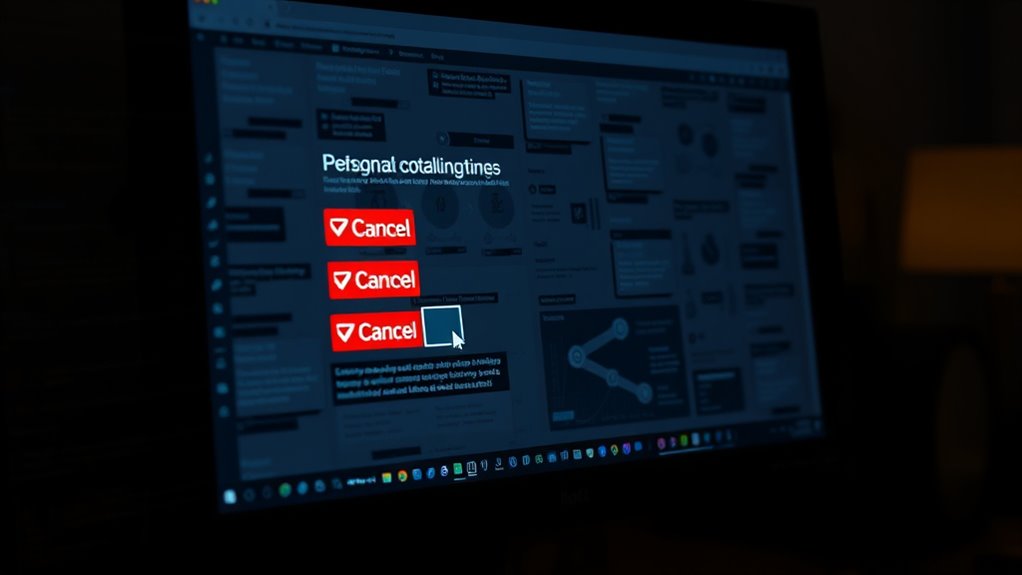Dark UX uses manipulative tactics like confusing layouts and emotional appeals to influence your decisions, often blurring the line between persuasion and manipulation. While some design choices aim to guide users positively, others exploit psychological triggers, undermining your autonomy and trust. Ethical UX respects your rights and promotes transparency. If you explore further, you’ll discover how to identify deceptive practices and maintain your control in digital interactions.
Key Takeaways
- Dark UX techniques manipulate users through misdirection and emotional triggers, blurring the line between persuasion and exploitation.
- Ethical design prioritizes transparency and honest communication to foster trust and empower users to make informed decisions.
- Manipulative tactics like fear appeals and fake social proof undermine user autonomy and damage long-term trust.
- Legal frameworks aim to regulate deceptive practices, but enforcement challenges complicate accountability for dark patterns.
- Responsible UX design balances influence with user well-being, ensuring persuasion does not cross into unethical manipulation.
Defining Dark UX and Its Techniques

Dark UX refers to design practices that manipulate users into taking actions they might not intend or prefer, often for the benefit of the business rather than the user. These techniques often appear user-centered but are crafted to exploit emotional appeal, nudging users toward decisions they may later regret. For example, subtle misdirection, confusing layouts, or emotionally charged language can influence your choices without your full awareness. Dark UX prioritizes persuasion over transparency, using psychological triggers to increase engagement or revenue. While these tactics may seem helpful or necessary, they blur ethical lines by undermining genuine user autonomy. Recognizing these techniques helps you stay aware of how design influences your behavior, especially when emotional appeals are used to bypass your rational decision-making. Additionally, understanding the use of water-related imagery and themes can reveal how environments like water parks or aquatic settings are sometimes employed to create a sense of calm or escape, subtly influencing user perceptions and decisions.
The Fine Line Between Persuasion and Manipulation

You need to contemplate whether your design genuinely helps users or if it manipulates their choices. When the intent behind your design isn’t clear, users can feel disoriented or exploited. Transparency and clarity are vital to guarantee you’re guiding rather than misleading them. Being aware of personal debt forgiveness bills can influence how you present financial options ethically, ensuring you don’t exploit users’ financial vulnerabilities.
Intent Behind Design
While persuasive design can guide you toward beneficial actions, it often walks a fine line with manipulation when its intent shifts from helpful to exploitative. The key lies in understanding the intent behind the design. When designers use motivational framing, they aim to encourage positive behavior, such as signing up for a newsletter or completing a purchase. However, emotional appeals can blur ethical boundaries, especially when they manipulate your feelings to drive decisions you might not make rationally. If the intent is to benefit the user, transparency and honesty remain central. But if the goal is solely to maximize engagement or profits at your expense, it crosses into manipulation. Recognizing this intent helps you differentiate between genuinely helpful designs and those crafted to exploit your vulnerabilities. Additionally, awareness of the principles of the Law of Attraction can help individuals discern genuine influence from manipulative tactics.
User Autonomy Limits
Designers often push the boundaries of your autonomy by subtly steering your choices through persuasive techniques. They exploit cultural influences and assumptions about user diversity to craft experiences that nudge decisions without clear notice. These tactics can limit your ability to make fully informed, independent choices, blurring the line between helpful guidance and manipulation. For example, culturally tailored prompts might influence your preferences, while unfamiliar interface designs could restrict your options. Recognizing these limits is vital because they shape how freely you can act within digital environments. When design subtly constrains your decision-making, it risks undermining your sense of control. Additionally, awareness of home furnishings safety features can help users make informed decisions about product use and avoid potential hazards. Ultimately, understanding where boundaries are pushed helps you see when persuasion crosses into manipulation, highlighting the importance of preserving your genuine user autonomy.
Transparency and Clarity
Transparency and clarity are essential in digital design because they determine whether you can truly understand what’s happening and make informed choices. Deceptive interfaces often obscure information, making it hard to recognize manipulative tactics. Hidden opt-ins are a prime example, where users unknowingly agree to things they wouldn’t if fully informed. When designers prioritize transparency, they present clear, honest information about what users are agreeing to, avoiding tricks that manipulate decision-making. Clarity builds trust and empowers you to control your experience. Without it, you risk falling into manipulation, where your choices are shaped by confusing or misleading design. Striking the right balance means being honest about intentions and ensuring users understand exactly what they’re consenting to. Additionally, understanding the concept of Forsale 100 helps highlight how some designs prioritize profit over user well-being, further emphasizing the need for transparency.
Ethical Principles in User Experience Design

Ethical principles in user experience design serve as the foundation for creating interfaces that respect users’ rights and foster trust. To achieve this, you should be aware of psychological bias, which can skew user perception and decision-making. Designing with integrity means avoiding tactics that exploit these biases for market influence, such as manipulative countdown timers or hidden fees. Instead, focus on transparency, fairness, and user autonomy. Upholding these principles helps prevent dark UX practices that undermine trust and can lead to harm. When you prioritize ethical considerations, your designs promote genuine engagement and respect user dignity. Additionally, understanding the role of prophetic dreams can inspire designers to seek deeper insight into user needs and motivations. Ultimately, good UX balances business goals with a moral obligation to empower users, ensuring that persuasion remains ethical and free from manipulation.
The Impact of Dark UX on User Trust and Loyalty

When dark UX tactics are used to manipulate user behavior, they can quickly erode trust and damage long-term loyalty. Relying on emotional appeals, such as fear or guilt, may prompt immediate actions but often leave users feeling deceived later. Social proof, like fake reviews or misleading indicators of popularity, can create a false sense of security and influence decisions unfairly. Over time, these tactics undermine your confidence in the platform, making you less likely to return or recommend it. While they might generate short-term gains, they damage the relationship between you and the company. Genuine trust is built on transparency and respect, not on manipulative design, which ultimately harms both your experience and the company’s reputation. Recognizing the importance of authentic content can help users differentiate between honest information and manipulative tactics.
Recognizing Manipulative Design Practices

Recognizing manipulative design practices requires a keen eye for subtle cues that steer your choices without your awareness. Dark patterns often exploit emotional triggers, making you feel urgency, fear, or guilt to push you toward a decision. For example, confusing opt-out options or hidden charges can manipulate your actions. Look out for designs that use countdown timers or overly persuasive language to create a false sense of scarcity. These tactics tap into emotions to bypass rational judgment, subtly guiding you toward choices that benefit the designer or company. Being aware of these cues helps you identify when you’re being manipulated. By recognizing dark patterns and emotional triggers, you gain control over your decisions and protect yourself from unethical persuasion techniques. Awareness of Dark Pattern Recognition allows consumers to better protect themselves from deceptive practices.
Regulatory and Legal Perspectives on Dark UX

Regulators are stepping in to address illegal and deceptive practices associated with Dark UX, but enforcement often faces obstacles. You need to understand which laws are being violated and how authorities identify and act on these violations. Managing regulatory challenges is vital for holding companies accountable and protecting consumer rights. Implementing mindful decluttering strategies can also help organizations foster transparency and build consumer trust by ensuring clarity and honesty in their user interfaces.
Legal Standards and Violations
Legal standards surrounding Dark UX are evolving as authorities recognize how deceptive design practices can harm consumers and undermine fair competition. You have the right to transparent and honest interactions online, and companies can face legal liabilities if they manipulate or deceive users. Laws like the Federal Trade Commission Act in the U.S. enforce rules against unfair or deceptive practices, including misleading interfaces. European regulations, such as the GDPR, emphasize data transparency and user consent, indirectly addressing Dark UX tactics. Violating these standards can lead to fines, lawsuits, or reputational damage. As a user, your consumer rights are protected, but it’s essential for organizations to understand that employing manipulative design can have serious legal consequences. Responsible design aligns with both ethical standards and legal obligations. Additionally, the Horsepower of Electric Dirt Bikes concept highlights the importance of transparency in product capabilities, which parallels the need for clear and honest user interfaces.
Regulatory Enforcement Challenges
Enforcing regulations against Dark UX practices presents significant challenges for authorities worldwide. Market regulation often struggles to keep pace with rapid technological advancements and evolving user interfaces designed to manipulate. Many companies operate across borders, complicating jurisdiction and enforcement efforts. Compliance challenges arise because businesses may exploit legal gray areas or lack awareness of emerging standards. Identifying deceptive design choices requires ongoing monitoring and technical expertise, which isn’t always available to regulators. Additionally, enforcement can be hindered by limited resources and the difficulty in proving intentional deception. As Dark UX tactics become more sophisticated, authorities must develop clearer guidelines and stronger international cooperation to effectively address these compliance challenges and protect consumers from manipulative practices.
Fostering Ethical Design in Digital Products

To foster ethical design in digital products, you must prioritize user well-being over short-term gains. Use emotional appeals honestly to create genuine connections, avoiding manipulation. Incorporate color psychology thoughtfully, choosing colors that evoke trust and comfort rather than those that pressure or mislead users. Transparency is key; clearly communicate what data you collect and how it’s used. Design interfaces that empower users to make informed decisions without sneaky tactics like dark patterns. Respect user autonomy by avoiding unnecessary interruptions or manipulative prompts. Focus on creating a positive experience that builds trust and loyalty. Ethical design isn’t just about compliance—it’s about valuing users as people, not just data points or revenue sources. When you put users first, you foster long-term relationships rooted in integrity.
Navigating the Future of Persuasive UX Responsibly

As persuasive UX continues to evolve, designers face the challenge of balancing influence with responsibility. Neural influence and subconscious cues can powerfully shape user behavior without explicit awareness. To navigate this future ethically, you must prioritize transparency and consent. Avoid relying solely on manipulative tactics that exploit subconscious cues, which can erode trust over time. Instead, focus on designing experiences that empower users to make informed decisions. Stay informed about emerging technologies that tap into neural influence, and consider their ethical implications. By fostering a culture of responsible persuasion, you can create digital environments that respect user autonomy while still guiding behavior positively. Ultimately, responsible navigation requires ongoing reflection on your design choices and their impact on user trust.
Frequently Asked Questions
How Can Users Protect Themselves From Manipulative UX Tactics?
To protect yourself from manipulative UX tactics, stay vigilant about privacy concerns and always read the fine print before clicking. Be cautious of hidden prompts and misleading buttons that push for unnecessary permissions or purchases. Seek informed consent by questioning whether the design nudges you into decisions you’re uncomfortable with. Use privacy settings and browser extensions to block tracking, empowering you to navigate online spaces confidently and safely.
Are There Cultural Differences in Perceptions of Dark UX?
You might notice that perceptions of dark UX vary across cultures due to differing cultural sensitivity and ethical standards. In some regions, certain persuasive tactics are seen as acceptable, while others view them as manipulative. You should be aware that what’s considered ethical in one culture might not be in another, so designers and users alike need to respect diverse perspectives and prioritize transparency to avoid crossing ethical boundaries.
What Role Do Companies Play in Promoting Ethical UX Practices?
You play a key role in promoting ethical UX practices by urging companies to prioritize corporate accountability and transparency initiatives. By demanding clear, honest interfaces, you help hold organizations responsible for their design choices. Your support for transparency encourages companies to avoid manipulative tactics, fostering trust and respect. Ultimately, your advocacy pushes the industry toward responsible design, ensuring user interests are protected and ethical standards are upheld in digital experiences.
Can Dark UX Techniques Ever Be Justified Ethically?
You might wonder if dark UX techniques can ever be justified ethically. While they sometimes achieve short-term goals, they often cross moral boundaries and create ethical dilemmas by manipulating users without their consent. Using these tactics risks damaging trust and reputation. Ethical UX design respects user autonomy and transparency, ensuring you stay within moral boundaries. Ultimately, persuading users should never compromise their ability to make informed, voluntary choices.
How Does User Feedback Influence Ethical UX Redesigns?
User feedback plays an essential role in ethical UX redesigns by fostering user empowerment. When you actively listen and integrate feedback, you show respect for users’ needs and concerns. This process helps you create honest, transparent designs that prioritize user well-being over manipulation. By valuing feedback, you build trust, guarantee your designs align with ethical standards, and promote a positive experience that benefits both users and your brand.
Conclusion
As you design, remember that persuasion can build trust or erode it. Dark UX tricks may boost short-term gains, but they often sacrifice integrity and user loyalty. Striking a balance between influence and manipulation isn’t easy, yet it’s essential. By prioritizing ethical principles over deceptive tactics, you create products that respect users’ autonomy. Ultimately, choosing transparency over manipulation guarantees your designs stand the test of time—and trust—rather than fade into the shadows of Dark UX.









